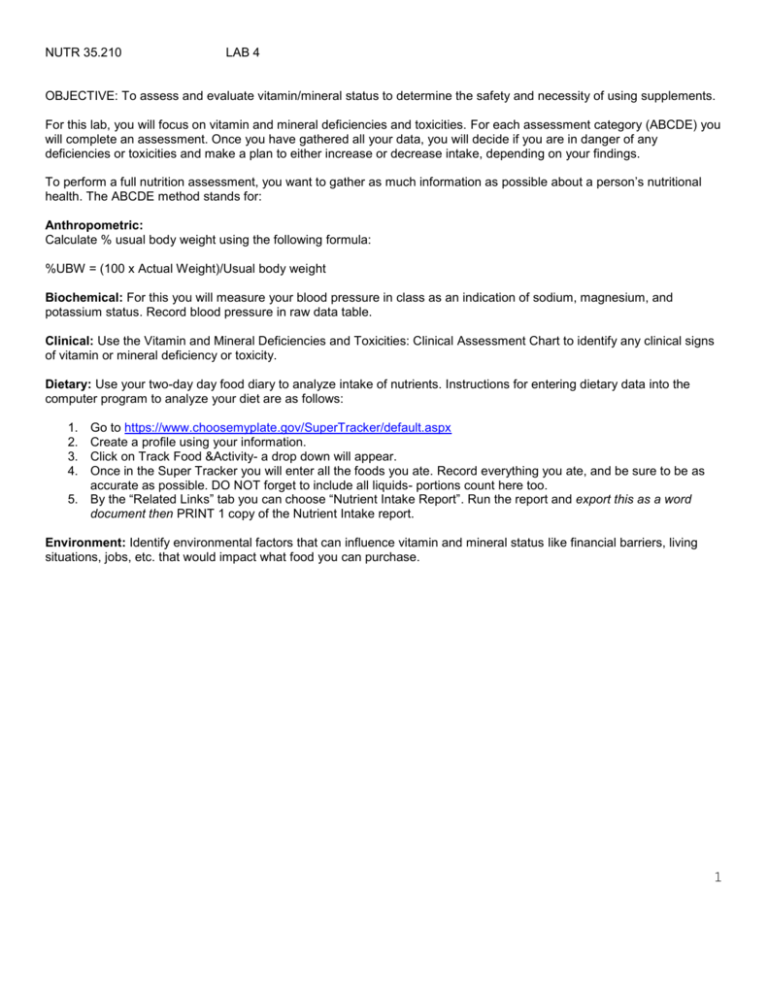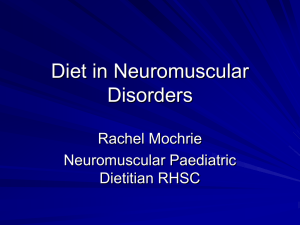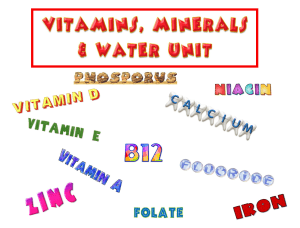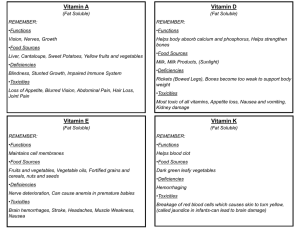NUTR 35.210 LAB 4 OBJECTIVE: To assess and evaluate vitamin
advertisement

NUTR 35.210 LAB 4 OBJECTIVE: To assess and evaluate vitamin/mineral status to determine the safety and necessity of using supplements. For this lab, you will focus on vitamin and mineral deficiencies and toxicities. For each assessment category (ABCDE) you will complete an assessment. Once you have gathered all your data, you will decide if you are in danger of any deficiencies or toxicities and make a plan to either increase or decrease intake, depending on your findings. To perform a full nutrition assessment, you want to gather as much information as possible about a person’s nutritional health. The ABCDE method stands for: Anthropometric: Calculate % usual body weight using the following formula: %UBW = (100 x Actual Weight)/Usual body weight Biochemical: For this you will measure your blood pressure in class as an indication of sodium, magnesium, and potassium status. Record blood pressure in raw data table. Clinical: Use the Vitamin and Mineral Deficiencies and Toxicities: Clinical Assessment Chart to identify any clinical signs of vitamin or mineral deficiency or toxicity. Dietary: Use your two-day day food diary to analyze intake of nutrients. Instructions for entering dietary data into the computer program to analyze your diet are as follows: 1. 2. 3. 4. Go to https://www.choosemyplate.gov/SuperTracker/default.aspx Create a profile using your information. Click on Track Food &Activity- a drop down will appear. Once in the Super Tracker you will enter all the foods you ate. Record everything you ate, and be sure to be as accurate as possible. DO NOT forget to include all liquids- portions count here too. 5. By the “Related Links” tab you can choose “Nutrient Intake Report”. Run the report and export this as a word document then PRINT 1 copy of the Nutrient Intake report. Environment: Identify environmental factors that can influence vitamin and mineral status like financial barriers, living situations, jobs, etc. that would impact what food you can purchase. 1 Lab report (Please type the final report) Introduction: Your introduction should include a short title for this lab. You also need a discussion of why this lab is important, what you hope to learn from it, and what the information gathered can be used for. Materials and Procedures: This section should include a list of any materials or supplies you used to complete this lab. You also need to include a step by step description of what you did during this lab. Results and Analysis: Please include, Raw data table - make sure you create a descriptive title for you raw data table Raw data: two-day food journal Vitamin and Mineral Deficiencies and Toxicities: Clinical Assessment sheet Your nutrient analysis report that analyzes your dietary data (from choosemyplate.gov) Conclusions: Create a table that includes TOTAL intake (from food and supplements) for all vitamins and minerals listed in the nutrient analysis report. Use the ABCDE method to summarize your findings about your nutrition status. Make sure to discuss whether any suspected deficiencies or toxicities put you at a health risk. If so, discuss how you can reduce health risks. Conclusions Part 2: Using the table you created in the Conclusions, add another column titled “supplements”. In this column, enter the nutrition information from the back of the bottle of any micronutrients supplements you take. If you do not take any supplements, find a multivitamin and mineral supplement (you can search online, or borrow a friend’s bottle) and add the nutrition information for all the micronutrients that are on your table. Now create one more row that adds your usual intake with your supplemental intake. Do you think most Americans need to take supplements? 2 Raw data table: Anthropometric/ Biochemical: Please create a title for this raw data table: Variable Weight from last week (lbs) Weight from this week week (lbs) Blood pressure (systolic) mmHg Blood pressure (diastolic) mmHg Value 3 Clinical Vitamin and Mineral Deficiencies and Toxicities: Clinical Assessment Chart (CIRCLE ANY THAT APPLY TO YOU) Vitamin/ Mineral Vitamin A Vitamin K Thiamine Riboflavin Niacin Vitamin B6 Folate Vitamin B12 Vitamin C Magnesium Iron Zinc Sodium Selenium Physical Signs of Deficiency Physical Signs of Toxicity Hair follicle blockage with a permanent “goose-bump” appearance Dry, rough, skin Small, grayish, foamy deposits on the conjunctiva adjacent to the cornea Drying of the eyes and mucous membranes Night blindness Small hemorrhages in the skin or mucous membranes Unexplained weight loss Muscular wasting Sometimes edema Malaise or fatigue Tense calf muscles Distended neck veins Jerky movement of eyes Difficulty walking Round, swollen (moon) face Tearing, burning, and itching of the eyes with fissuring in the corners of the eyes Soreness and burning of the lips, mouth, and tongue with fissuring and/or cracking of the lips and corners of the mouth Purple swollen tongue Capillary overgrowth around the corneas Bone pain Dermatitis or skin eruptions Tremors Sore tongue Diarrhea Tongue inflammation Inflammation of the lining of the mouth Fissures in the corners of the mouth Weakness, fatigue, and depression Pallor/pale skin Skin lesions Lemon-yellow tint to the skin and eyes Smooth, red, thickened tongue Impaired wound healing Edema Swollen, bleeding, and/or retracted gums or tooth loss; mottled teeth; enamel erosion Lethargy and fatigue Skin lesions Small red or purplish pinpoint discolorations on the skin or mucous membranes (petechiae) Darkened skin around the hair follicles Tremors, muscle spasms, and tetany Personality changes Skin pallor Pale conjuctivia Fatigue Thin, concave nails with raised edges Pica (ice chewing) Delayed wound healing Hair loss Skin lesions Eye lesions Rare None known Flushing, nausea, vomiting None known None known Bright yellow urine Tingling in hands None known None known Nausea, diarrhea, stomach cramps Diarrhea, cramps, nausea Nausea, vomiting, diarrhea, constipation Nausea, vomiting, cramps, diarrhea, impaired immune function Hypertension Brittle hair and nails, skin rash, garlic breath odor, fatigue 4 Instructor Signature______________________________________ Excellent (3 pts) Good (2 pts) Includes the question or purpose to be answered by One of the "excellent" the lab, states the reason Introduction conditions is not met, why this is important two conditions met and has a short, relevant title. Adequate (1 pts) Needs Work (0.5 pt) Two of the "excellent" conditions is not met, one is met Introduction present, no exemplary conditions met Not attempted (0) Would be difficult to Description or step-by-step The description gives Description included, repeat, reader must Materials and process is included, could generalities, enough for reader some steps are vague guess at how the data Procedures be repeated by another to understand how the lab was or unclear was gathered or lab was scientist conducted conducted Results and data are clearly Results are clear and Results are unclear, missing Results are disorganized recorded, organized so it is labeled, trends are not labels, trends are not obvious, Results and or poorly recorded, do easy for the reader to see obvious or there are disorganized, there is enough Analysis not make sense; not trends. All appropriate labels minor errors in data to show the experiment enough data was taken are included organization was conducted 1. Summarizes data used to draw conclusions 2. Conclusions follow data 2 of 3 of the "excellent" Conclusions (not wild guesses or leaps of conditions is met logic), 3. Discusses applications or real world connections Answers all additional Conclusions questions required correctly. part 2 Answers 2 or 3 additional questions correctly. 1 of 3 of the "excellent" conditions is met Conclusion section is present but no conditions are met Answers 1 of 3 additional questions correctly. Attempts to answer questions but none are correct. 5









